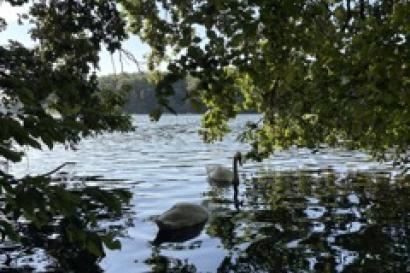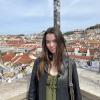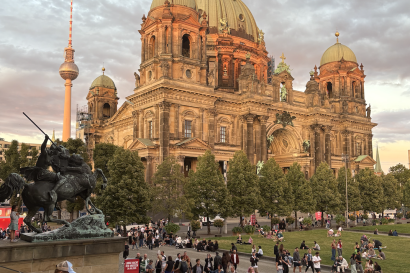Gogol’s short story “Nevsky Prospect” warns readers of the city’s pull and power, several other works we read described St. Petersburg as intense and even violent, and Anastasia, which some friends and I watched the night before our flight paints the city as a snow-blanketed dreamland. I had no mental image of the city or what my experiences there would be, but I can say now that St. Petersburg is the most remarkable place I’ve ever been.
I can’t discuss St. Petersburg without discussing the buildings. The city has a potent history and the visual landscape reflects this with not only beautiful but dignified architecture. I seldom saw post-modernist and contemporary looking buildings but instead, the streets were lined with massive baroque palaces in Easter egg colors with white and gold filigree trimming. The Church of Spilled Blood peaks out at the end of a block between two ornate buildings and looks like a castle with wildly colorful onions for turrets. Entering buildings felt like stepping into jewelry boxes or Fragonard paintings; the interior of the Hermitage with its elaborate gold moldings, camera picta walls and the lavish malachite and marble surfaces drew my attention just as much as most of the artwork (though I was able to forget my preference for over-the-top decorum to linger on Matisse’s “The Dance”). The same goes for the Marinsky Theater where we saw a traditional and—dare I say—perfect production of Swan Lake. I couldn’t take my eyes off the curtains, the ceiling, or even the velvet armrest in front of me.
At night the city takes on a different exciting attitude. My first night out, I walked with my eyes glued to the buildings, which after dark are lit from beneath their moldings, making the whole street glow. Out of nowhere, a man walking the opposite direction as me charged forward, clamp a hand on my arm and grabbed my waist with the other and started dragging me backwards. We had stumbled about five paces before my instincts kicked in and I wrenched my arm away. Even though I felt terrified in the moment, I am still grateful for the lesson. Cities have unique compositions and these compositions are always subject to change; we must learn to be as changing as the cities we get to experience. I learned quickly that night that different social rules apply in St. Petersburg than in Berlin or, naturally, Vermont. Strangers do not acknowledge each other and no one meanders on busy streets. This said, whenever I engaged people for directions, etc. they responded helpfully and hospitably. I don’t understand Russian culture much more than I understand the Russian alphabet, but I feel lucky to have experienced it and to have gained the metropolitan insight that everyone has to adjust to function in cities.
Speaking of adjusting, I left the city with only one bruise; a bus door opened unexpectedly and pinned me against the wall for a full minute before I was rescued by the driver.

Alli Green
<p><span style="color: rgb(29, 29, 29); font-family: Arial, Verdana, sans-serif; font-size: 12px; line-height: normal; background-color: rgb(237, 237, 237);">Having grown up in rural Vermont, Alli Green now studies art history and studio art at Skidmore College. She stays active on campus by working as admissions ambassador, a tutor in Skidmore’s writing center, and looks forward to assistant costume designing the theater department’s main stage production in the spring of 2014. Her ambitions include pursuing a master’s degree in either art history, museum studies, or library sciences, exploring opportunities to work as a field archeologist, illustrating children’s books, and contributing to the making of movie magic as a costume designer or special effects makeup artist. In the meantime, she is content to get excited about books, movies, art, history, and learning everything she can both while she is a student and after.</span></p>





